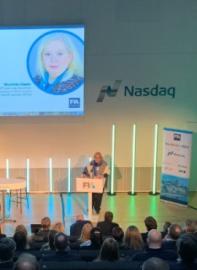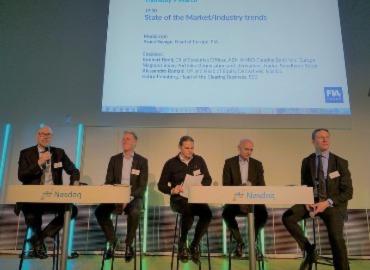Stockholm may seem to be on the periphery of Europe from a geographical perspective. But when it comes to the major issues impacting the European derivatives markets, it’s right in the thick of the action.
FIA came to Stockholm in March for the first in a series of forums around Europe with regulators, exchanges, brokers, clearing firms and other market participants. Three topics dominated the discussions: location requirements for central clearing, the implications of the ION Markets ransomware attack, and the imposition of a price cap on gas markets.
Location Requirement for Clearing
Nicoletta Giusto, a senior official at the European Securities and Markets Authority, kickstarted the forum with a keynote address outlining ESMA’s work over the coming months. Giusto is an independent member of ESMA's CCP Supervisory Committee, which was established in 2020 to guide its supervision of central clearinghouses.
First in her address was the topic of the European Commission’s proposed revisions to the European Market Infrastructure Regulation, known as EMIR 3.0. The revisions are focused on improving the attractiveness of EU CCPs and reducing exposures to "systemically important third-country CCPs" such as LCH.Clearnet Ltd and ICE Clear Europe in the UK.
One of the most far-reaching proposals is a requirement for financial institutions to hold "active accounts" at CCPs in the EU and use those accounts to clear a certain proportion of their derivatives trading.
The proposal focuses in particular on interest rate swaps denominated in euros and the Polish zloty as well as credit default swaps and short-term interest rate futures denominated in euros. If the proposal is accepted, ESMA will be given the responsibility of determining the minimum level of activity in the active accounts.
Giusto called the active account proposal a "balanced approach" that would preserve access to liquidity in London while ensuring that systemically important clearing services move to the EU.
“We believe that out of all the options considered to reduce the over-reliance on substantial systemic clearing services in the UK, the proposal now on the table by the Commission represents an attempt to achieve a balanced approach to ensure that a proportion of critical clearing services takes place in the Union while guaranteeing that EU markets also remain connected to the liquidity pool in London,” Giusto told the audience.
Giusto added that the proportion of swaps trading that needs to be cleared in the EU should not be written into the law, but rather determined through regulation, known as "level 2" measures in EU policymaking.
“We are of the view that sufficient flexibility should be left to Level 2 measures to ensure that both the list of precise products subject to the active account requirement and the proportion of activity to be cleared in the Union can evolve in time,” she said. “Markets move and evolve, and we should be able to adapt without reopening every time the legislative framework at Level 1.”
Giusto added that ESMA is carefully listening to comments pointing to potential duplication of reporting requirements in the Commission's proposal and the related cost for the industry.
Market participants warned, however, that the active account proposal was proving to be a sticking point and harmful to the overall objective of making the EU capital markets union more attractive.
Magnus McNeill, head of legal, compliance and risk management at Swedish banking group SEB, said that he was concerned that the amendments would increase costs for EU-based clearing members.
“Things start to be problematic when we have commercial decisions made for us about where we open accounts. As a multi-market regional provider, but not a global actor, we will not be able to maintain an unlimited number of relationships with CCPs,” he said.
“We do not support any kind of quantitative requirements and the jury is out about the value of this," McNeill added. "It is important that EU CCPs gain market share through the quality of their products and by developing their offerings.”
A clearing expert at SEB added that forcing clients to move some of their clearing out of the UK will result in splitting up portfolios and losing certain operational and financial benefits that arise when euro-denominated swaps are cleared alongside swaps denominated in US dollars, the pound sterling and other currencies.
“I want to give a flavor of what it is like for a Swedish asset manager," said Gabriel Vimberg, head of the clearing business at SEB. "Many will do some of their SEK IRS [interest rate swaps] clearing at Nasdaq, and then the [other] currencies at LCH. If the active account comes in for euros, they might need to look for a third clearinghouse with all the inefficiencies that brings, at least for pension funds,” he said. “Some of these entities in our part of Europe are small and may not want that kind of fragmentation.”
Other aspects of EMIR 3.0 got a more positive reception, however. Andreas Gustafsson, senior vice president, general counsel Europe at Nasdaq, pointed to the streamlining of supervisory procedures for the approval of new products and model changes for EU CCPs. This is a welcome step, Gustafsson said and will allow an EU CCP to be quicker to market with innovative proposals, which is critical to the competitiveness of the EU clearing ecosystem.
Cyber Security and Third-Party Service Providers
Cyber security was another hot topic at the forum. The ransomware attack on ION Markets at the end of January has highlighted the industry's dependence on a vast and interconnected network of third parties that support trading and clearing. ION's software is used by a significant number of firms that clear exchange-traded derivatives and the ransomware attack disrupted trade processing for several days.
Isabelle Boutin, European head of clearing sales at JP Morgan, said cyber security is a top priority at financial firms due to the interconnected nature of the markets.
"Cyber threat is top of the technology agenda, and we are also likely to see an increased regulatory focus on third-party vendors and vendor oversight,” Boutin said.
One of the challenges, however, is that large vendors play hardball on contract negotiations and limit the customers' rights to audit their services, according to panelists.
“As a regulated firm we have to get certain things in place but that is not the be-all and end-all of risk management around vendors. If we were only doing what the EBA [European Banking Authority] told us to, or what DORA [Digital Operational Resilience Act] tells us to do, we would be five years behind where we need to be,” SEB's McNeill said.
“But it is very challenging to go out and be told by infrastructure providers or technology firms that ‘these are our standard terms, and we do not negotiate for single firms.’ I think there will be less tolerance for that type of stance going forward. It will be a huge selling point for providers who are ahead of the game here.”
Nick Solinger, chief executive officer of FIA Tech, provided a vendor's perspective on the ransomware attack. FIA Tech processes give-up trades for futures brokers and clearing firms, so his firm had a bird's eye view of the problems caused by the outage at ION.
Solinger said that on a normal day, nearly all trades are processed on the day of the trade and the positions are transferred to client accounts at their clearing firms by the end of the day. But during the week of the cyber incident there were days where 12% to 18% of volume executed was not given out to end clearers until the day after the trade or beyond.
“On a normal day, that would be 2% or 3%, often due to delays from clients who maybe aren't in the same time zone as an exchange and do not get things done by the clearing cutoff. There was five-to-six times more late post-trade activity in the market on those days during the incident,” Solinger told the audience. “On a positive note, for the clearing brokers that were on the other side of those give-ups things looked very orderly in the market.”
Solinger added that as a technology provider, he is supportive of having more transparency and rigor introduced to the technology sector. He also noted that FIA Tech is supporting industry efforts to raise standards across all vendors that support critical workflow. This includes participating in FIA’s Derivatives Market Institute for Standards (DMIST).
Price Cap on Gas Futures
The European energy markets have been exceptionally volatile over the last two years. Even before Russia's invasion of Ukraine, prices for natural gas and electricity were rising on fears of a shortage, and the invasion added fuel to the fire.
In response, European policymakers have implemented a "market correction mechanism" that sets a ceiling on how high gas prices can go. That price cap applies to natural gas futures and will kick in if prices on the Dutch Title Transfer Facility, the reference point for the most actively traded futures contract, exceed €180 a megawatt-hour for three consecutive working days.
Nasdaq, which hosted the forum, operates one of the largest power and gas markets in the EU and many utilities use its futures to hedge energy price risk. Daniela Peterhoff, senior vice president, president of clearing and head of European markets strategy at Nasdaq, acknowledged the "special circumstances" that caused policymakers to take this approach but cautioned against measures that intervene with natural price formation.
“From a clearinghouse perspective, if you do not know how the price is formed, it makes it more difficult for the clearinghouse to operate," Peterhoff said. "We are not a fan of price caps, but at the same time, we understand the very special circumstances under which they have been put in place.”
Clearing members expressed similar concerns and warned that this intervention would cause their clients to shift trading to other markets that are not covered by the mechanism.
“I think the introduction of a price cap sets us back quite a few years in advancing European financial markets. This is especially concerning given the recent EU push to make EU markets more attractive,” said Robbert Booij, chief executive officer, ABN AMRO Clearing Bank Europe, one of the largest futures brokers and clearing firms in Europe.
“Parties will always find the best price to hedge their risk and the moment an exchange-traded product no longer reflects the real economic value, market participants will go off-exchange to hedge their risk against a price that does reflect the real economic value. That is also why we are seeing new products being launched outside of the European Union, which are the same as the one subject to the cap.”
Market Modernisation
The forum also provided an opportunity for industry leaders to talk about new products and services.
Peterhoff talked about the initiatives Nasdaq is undertaking to advance the modernisation of markets. Nasdaq is one of the largest providers of trading and clearing technology to other exchanges around the world, and it is at the forefront of efforts to move key functions into the cloud. For example, in the US Nasdaq has moved the trade matching engine for one of its options exchanges into a new operating environment that leverages cloud technology within its existing data center.
“We are moving both our own markets and our customers’ markets to the cloud at pace,” Peterhoff said. “As part of that, we are scaling our data centre in Carteret, NJ to support our cloud infrastructure. We are also working with our customers on their future blueprint of how they will be operating in the new setup.”
Nasdaq is also creating its own digital assets infrastructure, including a custody solution for the institutional space that will be rolled out first in the US and then Europe, as well as anti-financial crime technology for digital assets.
Another focus area is carbon markets. In 2021, Nasdaq acquired Puro.earth, a marketplace for carbon removal, which offers tradable instruments to clients like Microsoft and SEB. “This is an exciting space for us, one that is meaningful. It is one of the core growth initiatives that we are focused on,” Peterhoff said.
JP Morgan's Boutin highlighted an initiative, still at an early stage, by a consortium of banks to introduce a single agent-trust clearing model in Europe. European clearinghouses overwhelmingly use a principal-to-principal clearing model, in which clearing banks stand between their clients and the CCP. The US, in contrast, uses an FCM agency client clearing model where the FCM holds a customer’s contracts as agent-trustee under the direction of the customer in accordance with the customer agreement.
The aim of the European initiative is to remove the need for separate back-to-back transactions between a clearing member and its client by leveraging and replicating to the extent possible the US FCM client clearing structure in relation to client transactions.
“In Europe, you effectively have two transactions – one transaction between the clearinghouse and the clearing member, and then the clearing member and the client. In the US there is only one transaction,” Boutin said. “The main difference from our perspective is in terms of capital cost because in Europe, it is double weighted – one is counting the transaction twice. This new model would help alleviate the cost base and free some capacity. We are doing a lot of the legal preparation for a transition, and we are hopeful that the new model may become the standard in the coming years.”
FIA will continue its European events with forums in Brussels, Leipzig and Frankfurt scheduled on 23 May, 29 June, and 12 October, respectively. The forums provide an opportunity for discussions to take place between regulators and the industry, and for participants to engage in productive conversations about the issues affecting their markets.
Visit FIA Flickr to see photos from FIA Forum Stockholm.
Visit FIA.org/events for more information on events taking place this year.






